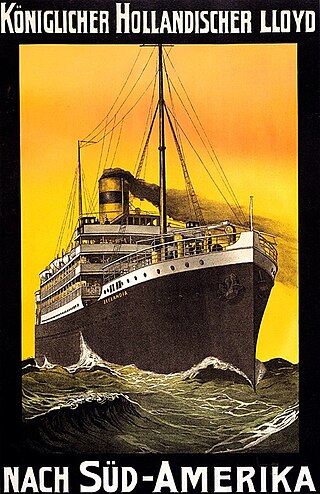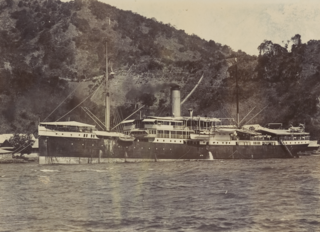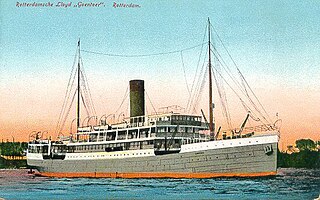Holland America Line is a US-owned cruise line, a subsidiary of Carnival Corporation & plc headquartered in Seattle, Washington, United States.

SS Dwinsk was a transatlantic ocean liner that was launched in Ireland in 1897 as Rotterdam, renamed C. F. Tietgen in 1906, and renamed Dwinsk in 1913. A U-boat sank her in 1918, with the loss of 23 lives. The ship was built for Holland America Line, but was successively owned by Scandinavian America Line and Russian American Line, and after the Russian Revolution she was managed by Cunard Line.

SS Potsdam was a steam ocean liner that was launched in Germany in 1899 for Holland America Line. In 1915 Swedish American Line acquired her and renamed her Stockholm.

SS Noordam was a steam ocean liner that was launched in Ireland in 1901 and scrapped in the Netherlands in 1928–29. Holland America Line owned her throughout her career. From 1923 to 1924 Swedish American Line chartered her and renamed her Kungsholm.

USS Rijndam (ID–2505) was the Holland America Line (HAL) ocean liner Rijndam, also spelt Ryndam, which was launched in Ireland in 1901 and scrapped in the Netherlands in 1929. The US requisitioned her as the United States Navy troopship USS Rijndam from 1918 until 1919. She was the first of four Holland America Line ships to be called Ryndam.

USS Bali was a Dutch cargo steamship that was built for Stoomvaart Mattschappij Nederland in 1917. She served in the United States Navy, with the ID number ID–2483, from March 1918 until May 1919. She supplied the American Expeditionary Forces in France, and in 1919 she took food relief to Europe.

USS Maartensdijk was a cargo steamship that was laid down in England in 1902 as Egyptiana, but launched as Rapallo. She served in the United States Navy as USS Maartensdijk from 1918 until 1919, with the Naval Registry Identification Number ID-2497.

SS 's Jacob was a passenger steamship that was launched in the Netherlands in 1907 and sunk by enemy action off New Guinea in 1943. She spent most of her career with Koninklijke Paketvaart-Maatschappij, based in the Dutch East Indies.

USS Zeelandia was an ocean liner that was built in Scotland in 1910 and scrapped in the Netherlands in 1936. She was the largest ship in the Koninklijke Hollandsche Lloyd (KHL) fleet from 1910 until the liners Gelria and Tubantia were completed in 1913 and 1914. She was USS Zeelandia from April 1918 until October 1919, when she was a United States Navy troopship.

SS Zaanland was a cargo steamship that was built in Scotland in 1900 for Dutch owners, and sunk in a collision in 1918. She was built for the Zuid-Amerika Lijn, which in 1908 became Koninklijke Hollandsche Lloyd. The US Government requisitioned her in March 1918 as USS Zaanland, with the Naval Registry Identification Number ID–2746. She was sunk in a collision less than two months later.

USS Oosterdijk was a Holland America Line cargo steamship that was built in 1913 and sank as a result of a collision in 1918. She served in the United States Navy, with the Naval Registry Identification Number ID–2586, from March 1918 until her loss that July. Some sources anglicise her name as Oosterdyk, but Lloyd's Register registered her with the Dutch spelling Oosterdijk.

USS Beukelsdijk was a Dutch-owned turret deck ship that was built in England in 1903 as Grängesberg. She was renamed Beukelsdijk in 1916 when she changed owners. In 1918 she was requisitioned as USS Beukelsdijk, with the Naval Registry Identification Number ID–3135. She returned to civilian service in 1919, and was wrecked in the Norwegian Sea in 1923.
SS Binnendijk was a Holland America Line (NASM) cargo steamship. She was one of NASM's "B" class ships: the company's first cargo ships to be powered by steam turbines. Binnendijk was built in South Holland in 1921, and sunk by a mine in the English Channel in 1939. She was the first ship that NASM lost in the Second World War. Her wreck off the coast of Dorset, England is now a wreck diving site, nicknamed "The Benny".

SS Ophir was a Dutch steamship that was built in 1904. She carried passengers, cargo and mail between Rotterdam and the Dutch East Indies until March 1918, when the United States seized her under angary and she became USS Ophir (ID-2800). In November 1918 a fire and explosion damaged her beyond economic repair. She was scrapped in 1922.

SS Van Heemskerk was a passenger steamship that was launched in the Netherlands in 1909 and sunk by enemy action off New Guinea in 1943. She spent most of her career with Koninklijke Paketvaart-Maatschappij, based in the Dutch East Indies.

Royal Rotterdam Lloyd was a Dutch shipping line that was established in Rotterdam in 1883 as Rotterdamsche Lloyd (RL). It became "Royal Rotterdam Lloyd" in 1947. RL mainly operated scheduled passenger and mail services between Rotterdam and the Dutch East Indies. Its independent existence ended in 1970, when KRL merged with four other Dutch shipping companies to form the Nederlandsche Scheepvaart Unie (NSU). In 1977 NSU became Nedlloyd.

SS Koningin der Nederlanden was a Dutch passenger steamship. She was built in 1911 for Stoomvaart Maatschappij Nederland, which ran scheduled passenger and mail services between Amsterdam and Java.

SS Aquileia was a Dutch-built steamship that was launched in 1913 as the ocean liner and mail ship Prins der Nederlanden for Netherland Line. She ran scheduled services between Amsterdam and the Dutch East Indies until 1930, when she was laid up.

SS Goentoer was a Dutch passenger and mail ship that was built for Rotterdamsche Lloyd in 1902 and scrapped in 1925. Her regular route was between Rotterdam and the Dutch East Indies. She was a UK troop ship from 1918 to 1919, after being seized under angary in Singapore.

SS Westerdijk was a Holland America Line cargo steamship that was completed in 1913 and scrapped in 1933. She served in the United States Navy, with the Naval Registry Identification Number ID–2514, from March 1918 until September 1919. Some sources anglicise her name as Westerdyk, but Lloyd's Register registered her with the Dutch spelling Westerdijk.


















